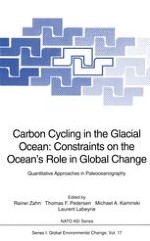1994 | OriginalPaper | Chapter
The History of Barium, Biogenic Silica and Organic Carbon Accumulation in the Weddell Sea and Antarctic Ocean Over the Last 150,000 Years
Authors : Graham Shimmield, Shirley Derrick, Andreas Mackensen, Hannes Grobe, Carol Pudsey
Published in: Carbon Cycling in the Glacial Ocean: Constraints on the Ocean’s Role in Global Change
Publisher: Springer Berlin Heidelberg
Included in: Professional Book Archive
Activate our intelligent search to find suitable subject content or patents.
Select sections of text to find matching patents with Artificial Intelligence. powered by
Select sections of text to find additional relevant content using AI-assisted search. powered by
Over the last decade many regional palaeoceanographic studies have found evidence for enhanced primary productivity during glacial episodes, particularly in the equatorial Pacific and off northwest Africa. These studies have given rise to the “glacial productivity hypothesis” which has suggested that enhanced oceanic biomass during glacial times supported an efficient removal of organic carbon from the euphoric zone, contributing to lower atmospheric CO2 levels recorded in ice cores. Recently, studies from the Southern Ocean have shown that south of the Antarctic Polar Front glacial palaeoproductivity was lower than during interglacial times. Here we present further evidence for enhanced interglacial productivity in the Southern Ocean using a transect of cores collected from the Scotia Sea and Weddell Sea. Biogenic silica, organic carbon and barium are presented as proxy indicators of past productivity. In order to establish such palaeoproductivity records for this region, where an absence of foraminifera precludes the standard use of δ18O stratigraphy and carbonate 14C dating, we have developed a method based on the synchronous removal of barium to the sea floor by scavenging and the formation of barite within the frustules of marine diatoms. The barium record is calibrated to a δ18O Specmap time scale from a single core at 68° 45′S, 5° 53′W (PS 1506) where planktonic and benthic foraminifera are found. One core from the Weddell Sea has been studied using the 230Thxs dating method to confirm the barium stratigraphy. Using the age models developed here, we identify important increases in palaeoproductivity during isotope stage 5e, and during the Holocene (Stage 1). Some evidence for a decrease in productivity during a cooling event between 11,000 and 12,000 years BP is observed. Highest palaeoproductivity, defined by biogenic opal accumulation, occurs in the vicinity of the Scotia Arc, just south of the present-day Antarctic Polar Front. Glacial productivity (18 to 72 ky BP) was weaker and displaced slightly to the north. The extent of glacial sea ice is considered to be of primary importance in governing the budget of biogenic detritus to these Southern Ocean sediments.
